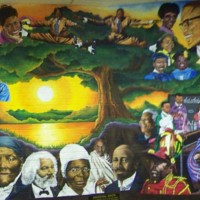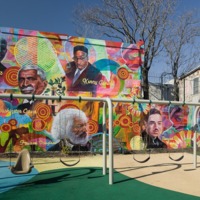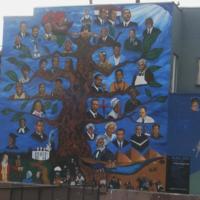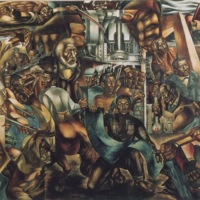![Nelson Stevens, Centennial Vision, Tuskegee University Administration Building, AL, 1980 [destroyed].jpg.gif Nelson Stevens, Centennial Vision, Tuskegee University Administration Building, AL, 1980 [destroyed].jpg.gif](https://486312.frmmmguz.asia/files/square_thumbnails/1a0ef8af8ec25559e5c2c7c66502ba40.jpg)
Centennial Vision
In 1980, on the anniversary of the founding of the Tuskegee Institute, AfriCOBRA member Nelson Stevens created a mural to celebrate the occasion. Although Stevens was commonly an exterior mural painter, he created this mural on the inside of the Tuskegee University Administration Building. The mural contains the images of black history figures such as Booker T. Washington (former president of Tuskegee University), General Chappie James and the Tuskegee airmen of World War II, Cinque, Malcolm X, Martin Luther King Jr., and George Washington Carver, as well as the antislavery figures Harriet Tubman, Sojourner Truth and Frederick Douglass. Also included in the image is a phrase made famous by the African scholar John S. Mbiti, “I Am Because We Are.” This mural no longer exists.

Ancestral Roots
Pontella Mason is one of Baltimore’s unsung visual artists. He has created murals for the Anacostia Community Museum, former President Jimmy Carter, and several other public organisations. His murals depict African American life and the diaspora. In 1999, he created the extensive mural Ancestral Roots, which depicts the antislavery heroes Harriet Tubman, Sojourner Truth, and Frederick Douglass, as well as Martin Luther King Jr., Malcolm X, Muhammad Ali, Notorious B.I.G., Tupac, Shirley Chisholm, and Marcus Garvey.

The Faces That Shape Us
On May 25, 2011, a mural titled The Faces That Shape Us, was dedicated in Uncle David’s Playground. Mr Kenneth Gamble (pictured on the mural), the founder and chairman of Universal Companies, had bought a rundown building in South Philadelphia and tore it down. He wanted to bring something positive to the neighbourhood and so he funded a local children’s playground, complete with a mural. Muralists Keir Johnston and Ernel Martinez started the mural in the summer of 2010. The mural features Frederick Douglass and other historical figures such as W.E.B. Du Bois, George Washington Carver and James Baldwin, as well as local figures Dr. Emmett Chapell, Judge Frederica Jackson, and Faatimah Gamble. The mural was developed through a partnership with Universal Companies, the Philadelphia Prison System and the City of Philadelphia Department of Human Services.
![Curtis Lewis, African Amalgamation of Ubiquity, 9980 Gratiot Avenue, Detroit, Michigan, 1985 [destroyed in 2013].jpg Curtis Lewis, African Amalgamation of Ubiquity, 9980 Gratiot Avenue, Detroit, Michigan, 1985 [destroyed in 2013].jpg](https://486312.frmmmguz.asia/files/square_thumbnails/3ac63b31ad894031e7c74b99651ace4a.jpg)
African Amalgamation of Ubiquity
In 1985, muralist Curtis Lewis created a mural on the side of a drug rehabilitation centre on Gratiot Avenue, Detroit, Michigan. The building belonged to Operation Get Down and included the antislavery figures Frederick Douglass and Harriet Tubman, as well as Malcolm X, Mary McLeod Bethune, Jesse Jackson, Thurgood Marshall, Martin Luther King Jr., W.E.B. Du Bois, Booker T. Washington, Ida B. Wells, Marcus Garvey and Nelson Mandela, alongisde Egyptian, Nubian and pharaoh figures. The man who breaks free of his chains in the centre of the mural holds a sign that reads, “Behold my people, arise, stand strong and proud, for ye come from pharaohs, emperors, kings and queens.” The mural was destroyed in 2013.

Black Seeds
In 1991, a group of artists – Eddie Orr, David Mosley, William T. Stubbs, Norman Maxwell and Michael McKenzie – collaborated to paint “Black Seeds” on an empty wall in Leslie N. Shaw Park on Jefferson and 3rd Avenue in Los Angeles. The idea for the mural, which appears as an African American tree of life, came from Vietnam veteran and local activist Gus Harris Jr. He recalled how little he learned about African American history in school. He wanted to create a public mural about black individuals who made an important contribution to society.The mural was created under the Social and Public Art Resource Center's 1990-91 “Neigborhood Pride: Great Walls Unlimited” mural program and features the antislavery leaders Harriet Tubman and Frederick Douglass, as well as Booker T. Washington, Thurgood Marshall, Mary McLeod Bethune, Malcolm X, George Washington Carver, Paul Robeson, Stevie Wonder, Shirley Chisholm, Martin Luther King Jr., and Jesse Jackson. The mural was restored by Moses X. Ball to include Barack Obama after 2008. The original canvas upon which the mural was based hangs in Oaks Jr. Market Corner Store at 5th and Jefferson.

The Contribution of the Negro to Democracy in America
In 1941, the artist Charles White was awarded $2000 from the Julius Rosenwald Fellowship for an ambitious project that included the creation of Contribution of the Negro to Democracy in America. Two years later, he unveiled the mural at the Hampton Institute in Virginia.The central figure has chains around his wrists that also loop around the necks of three other figures. But the shackles on the figure’s wrists are ready to be broken by the abolitionists: Frederick Douglass, Nathaniel Turner, Denmark Vesey, Harriet Tubman and Peter Still.